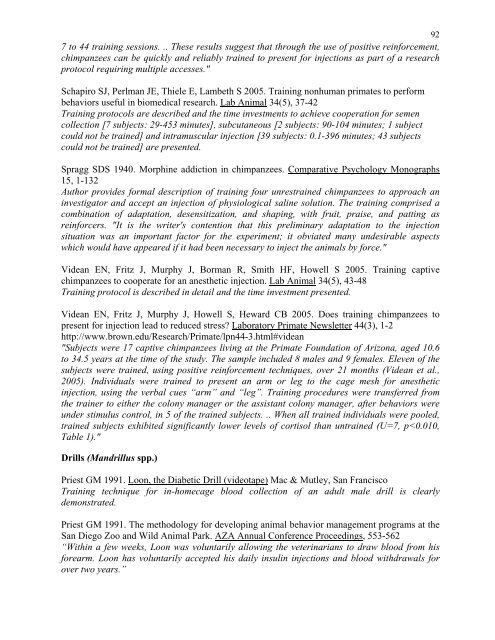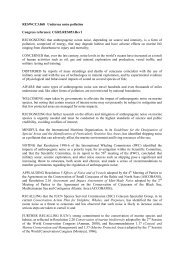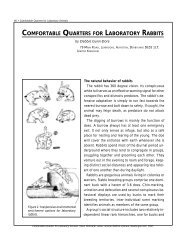91Training technique is described. "Thirty-seven [group-housed] captive chimpanzees weretrained using operant co<strong>nd</strong>itioning to enter a transfer box." [Age a<strong>nd</strong> sex of subjects is notprovided.]Lambeth SP, Perlman JE, Schapiro SJ 2000. Positive rein<strong>for</strong>ce<strong>ment</strong> training paired withvideotape exposure decreases training time invest<strong>ment</strong> <strong>for</strong> a complicated task in femalechimpanzees. American Journal of <strong>Prima</strong>tology 51(Supple<strong>ment</strong>), 79-80 (Abstract)“Five females were exposed to a 10-minute videotape of female chimpanzees being positivelyrein<strong>for</strong>ced <strong>for</strong> successfully urinating into a cup. Immediately following videotape exposure, thesesubjects participated in a training session." On average experi<strong>ment</strong>al a<strong>nd</strong> control subjectsreceived 56 minutes of training. "Subjects with videotape exposure successfully respo<strong>nd</strong>ed to thecomma<strong>nd</strong> to urinate in significantly less time than did controls."Laule GE, Thurston RH, Al<strong>for</strong>d PL, Bloomsmith MA 1996. Training to reliably obtain blood a<strong>nd</strong>urine samples from a diabetic chimpanzee (Pan troglodytes). Zoo Biology 15, 587-591Training techniques are described to gain the cooperation of a 3-year old female chimpanzee inobtaining blood a<strong>nd</strong> urine samples. "The first blood draw occurred during the 18th trainingsession, with a total of 275 minutes invested prior to that. The first successful [urine] collectionoccurred in session 4 in less than 4 min after a total of 42 min of training time."Laule G 1999 Training laboratory animals. In The UFAW [Universities Federation <strong>for</strong> AnimalWelfare] Ha<strong>nd</strong>book on the Care a<strong>nd</strong> Manage<strong>ment</strong> of Laboratory Animals Seventh Edition PooleT, <strong>En</strong>glish P (eds ), 21-27. Blackwell Science, Ox<strong>for</strong>d, UKVery helpful discussion of positive rein<strong>for</strong>ce<strong>ment</strong> training <strong>for</strong> cooperation during procedures."By making the shift to a more positive rein<strong>for</strong>ce<strong>ment</strong>-based system, the welfare of the animals issignificantly enhanced while providing better (less stressed) research models <strong>for</strong> the biomedicalcommunity."Perlman JE, Thiele E, Whittaker MA, Lambeth SP, Schapiro SJ 2004. Training chimpanzees toaccept subcutaneous injections using positive rein<strong>for</strong>ce<strong>ment</strong> training techniques. AmericanJournal of <strong>Prima</strong>tology 62(Supple<strong>ment</strong>), 96 (Abstract)http://www.asp.org/asp2004”Positive rein<strong>for</strong>ce<strong>ment</strong> training techniques were used to train four socially-housed, adultchimpanzees to present their abdomen <strong>for</strong> a subcutaneous injection. .. Subjects had beenpreviously trained to present body parts <strong>for</strong> inspection, including the abdomen. For the presentstudy, subjects were trained to 1) present the abdomen, 2) tolerate a pinch of the skin, 3) acceptthe subcutaneous insertion of a needle, a<strong>nd</strong> 4) remain stationary while the contents of the syringewere injected. Three of the four chimpanzees were reliably trained to voluntarily accept thesubcutaneous injection. A mean of 98 minutes of training time was required <strong>for</strong> the animals toreliably accept penetration a<strong>nd</strong> injection of up to 10 cc through a 25-gauge needle. Trainingsessions lasted 5 to 8 minutes a<strong>nd</strong> 13 - 20 sessions (mean = 17) were required to achievereliable per<strong>for</strong>mance.“Russell JL, Taglialatela JP, Hopkins WD 2006. The use of positive rein<strong>for</strong>ce<strong>ment</strong> training inchimpanzees (Pan troglodytes) <strong>for</strong> voluntary presentation <strong>for</strong> IM injections. American Journal of<strong>Prima</strong>tology 68(Supple<strong>ment</strong>), 122 (Abstract)"Positive rein<strong>for</strong>ce<strong>ment</strong> has been used to gain the cooperation of captive prim<strong>ates</strong> <strong>for</strong> researcha<strong>nd</strong> manage<strong>ment</strong> needs. In this study, ten chimpanzees .. were trained to present <strong>for</strong>intramuscular (IM) injections. Clicker training was used to teach subjects to present their lega<strong>nd</strong> accept an injection. .. Subjects reached criterion <strong>for</strong> presenting <strong>for</strong> a touch from a needle in
927 to 44 training sessions. .. These results suggest that through the use of positive rein<strong>for</strong>ce<strong>ment</strong>,chimpanzees can be quickly a<strong>nd</strong> reliably trained to present <strong>for</strong> injections as part of a researchprotocol requiring multiple accesses."Schapiro SJ, Perlman JE, Thiele E, Lambeth S 2005. Training nonhuman prim<strong>ates</strong> to per<strong>for</strong>mbehaviors useful in biomedical research. Lab Animal 34(5), 37-42Training protocols are described a<strong>nd</strong> the time invest<strong>ment</strong>s to achieve cooperation <strong>for</strong> semencollection [7 subjects: 29-453 minutes], subcutaneous [2 subjects: 90-104 minutes; 1 subjectcould not be trained] a<strong>nd</strong> intramuscular injection [39 subjects: 0.1-396 minutes; 43 subjectscould not be trained] are presented.Spragg SDS 1940. Morphine addiction in chimpanzees. Comparative Psychology Monographs15, 1-132Author provides <strong>for</strong>mal description of training four unrestrained chimpanzees to approach aninvestigator a<strong>nd</strong> accept an injection of physiological saline solution. The training comprised acombination of adaptation, desensitization, a<strong>nd</strong> shaping, with fruit, praise, a<strong>nd</strong> patting asrein<strong>for</strong>cers. "It is the writer's contention that this preliminary adaptation to the injectionsituation was an important factor <strong>for</strong> the experi<strong>ment</strong>; it obviated many u<strong>nd</strong>esirable aspectswhich would have appeared if it had been necessary to inject the animals by <strong>for</strong>ce."Videan EN, Fritz J, Murphy J, Borman R, Smith HF, Howell S 2005. Training captivechimpanzees to cooperate <strong>for</strong> an anesthetic injection. Lab Animal 34(5), 43-48Training protocol is described in detail a<strong>nd</strong> the time invest<strong>ment</strong> presented.Videan EN, Fritz J, Murphy J, Howell S, Heward CB 2005. Does training chimpanzees topresent <strong>for</strong> injection lead to reduced stress? Laboratory <strong>Prima</strong>te Newsletter 44(3), 1-2http://www.brown.edu/<strong>Re</strong>search/<strong>Prima</strong>te/lpn44-3.html#videan"Subjects were 17 captive chimpanzees living at the <strong>Prima</strong>te Fou<strong>nd</strong>ation of Arizona, aged 10.6to 34.5 years at the time of the study. The sample included 8 males a<strong>nd</strong> 9 females. Eleven of thesubjects were trained, using positive rein<strong>for</strong>ce<strong>ment</strong> techniques, over 21 months (Videan et al.,2005). I<strong>nd</strong>ividuals were trained to present an arm or leg to the cage mesh <strong>for</strong> anestheticinjection, using the verbal cues “arm” a<strong>nd</strong> “leg”. Training procedures were transferred fromthe trainer to either the colony manager or the assistant colony manager, after behaviors wereu<strong>nd</strong>er stimulus control, in 5 of the trained subjects. .. When all trained i<strong>nd</strong>ividuals were pooled,trained subjects exhibited significantly lower levels of cortisol than untrained (U=7, p
- Page 3:
Table of ContentsSpecies-typical Be
- Page 7 and 8:
2Behavioral Pathologies (Abnormal B
- Page 9 and 10:
Meyerson BJ 1986. Ethology in anima
- Page 11 and 12:
6"An animal treated unsympathetical
- Page 13 and 14:
8"If sufficient room is not provide
- Page 15 and 16:
Canadian Council on Animal Care 198
- Page 17 and 18:
12Platt DM, Kinsey JH, Jorgenson MJ
- Page 19 and 20:
14(7) Enforced RestraintAdams MR, K
- Page 21 and 22:
16Goosen DJ, Davies JH, Maree M, Do
- Page 23 and 24:
Norman RL, McGlone J, Smith CJ 1994
- Page 25 and 26:
20Crockett CM, Bowers CL, Shimoji M
- Page 27 and 28:
22(10) Double-tier Cage Arrangement
- Page 29 and 30:
National Research Council 1998. The
- Page 31 and 32:
26Coe CL 1991. Is social housing of
- Page 33 and 34:
28Tatoyan SK, Cherkovich GM 1972. T
- Page 35 and 36:
30Line SW, Morgan KN, Markowitz H,
- Page 37 and 38:
32Reinhardt V 1989. Evaluation of t
- Page 39 and 40:
34Clarke AS, Juno CJ, Maple TL 1982
- Page 41 and 42:
36The animals “spent most time in
- Page 43 and 44:
38Brent L, Belik M 1997. The respon
- Page 45 and 46: 40"Access to the puzzles was accomp
- Page 47 and 48: 42"The purpose of this study was to
- Page 49 and 50: 44Choi GC 1993. Humans enrich the l
- Page 51 and 52: 46“Eleven baboons who had been si
- Page 53 and 54: 48Reinhardt V, Houser WD, Eisele S,
- Page 55 and 56: 50Thompson MA, Bloomsmith MA, Taylo
- Page 57 and 58: (7) Working with Cooperative Animal
- Page 59 and 60: 54Lambeth SP, Hau J, Perlman JE, Ma
- Page 61 and 62: 56Smith M, Barley J, Down N, Franci
- Page 63 and 64: Environmental Enrichment58(1) Defin
- Page 65 and 66: 60Baker KC, Seres M, Aureli F, de W
- Page 67 and 68: 62Judge PG, de Waal BM, Paul KS, Go
- Page 69 and 70: (2,1,b) Group-housing: Group Format
- Page 71 and 72: 66McNary JK 1992. Integration of ch
- Page 73 and 74: 68Clarke MR, Blanchard JL 1994. All
- Page 75 and 76: Watts E 1997. Introductions. In Ora
- Page 77 and 78: 72Baumans V, Coke C, Green J, Morea
- Page 79 and 80: 74Hotchkiss CE, Paule MG 2003. Effe
- Page 81 and 82: 76Reinhardt V, Hurwitz S 1993. Eval
- Page 83 and 84: 78Shively CA 2001. Psychological we
- Page 85 and 86: 80“The establishment of dominance
- Page 87 and 88: 82Reinhardt V 1991. Agonistic behav
- Page 89 and 90: Abney D, Conlee K, Cunneen M, Down
- Page 91 and 92: 86Boccia ML, Broussard C, Scanlan J
- Page 93 and 94: Southey ER, Baldwin CM 2006. Social
- Page 95: T-W-Fiennes RN 1972. Primates - Gen
- Page 99 and 100: 94Baumans V, Coke C, Green J, Morea
- Page 101 and 102: 96Skoumbourdis EK 2008. Pole-and-co
- Page 103 and 104: 98Tamarins (Saguinus spp.)Smith TE,
- Page 105 and 106: 100Bertrand F, Seguin Y, Chauvier F
- Page 107 and 108: 102Gilloux I, Gurnell J, Shepherdso
- Page 109 and 110: 104Molzen EM, French JA 1989. The p
- Page 111 and 112: 106Reinhardt V 1992. Foraging for c
- Page 113 and 114: 108Boccia ML 1989. Long-term effect
- Page 115 and 116: 110Baumans V, Coke C, Green J, More
- Page 117 and 118: 112”We give our pair-housed cynos
- Page 119 and 120: 114use their hands to obtain and pr
- Page 121 and 122: 116MacLean E, Roberts Prior S 2006.
- Page 123 and 124: Bayne K, Hurst JK, Dexter SL 1992.
- Page 125 and 126: 120Phillippi-Falkenstein K 1998. Us
- Page 127 and 128: 122Shimoji M, Bowers CL, Crockett C
- Page 129 and 130: Anonymous 1991. The psychological w
- Page 131 and 132: 126Pruetz JD, Bloomsmith MA 1992. C
- Page 133 and 134: 128Reinhardt V 1990. Time budget of
- Page 135 and 136: 130O'Neill PL, Wright AC, Weed JL 1
- Page 137 and 138: 132above ground level. I very often
- Page 139 and 140: 134Canadian Council on Animal Care
- Page 141 and 142: 136International Primatological Soc
- Page 143 and 144: 138forage daily, by scattering food
- Page 145 and 146: 140sensory and emotional experience
- Page 147 and 148:
142Bayne K 1989 Resolving issues of
- Page 149 and 150:
144creation? Very unlikely!I think
- Page 151:
146Spaeth GL 1994. Editorial: Carin
















